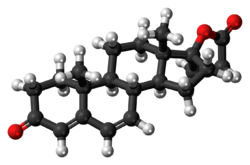Chemistry:Canrenone
 | |
 | |
| Clinical data | |
|---|---|
| Trade names | Contaren, Luvion, Phanurane, Spiroletan |
| Other names | Aldadiene;[1] SC-9376; RP-11614; 7α-Desthioacetyl-δ6-spironolactone; 6,7-Dehydro-7α-desthioacetylspironolactone; 17-Hydroxy-3-oxo-17α-pregna-4,6-diene-21-carboxylic acid γ-lactone |
| AHFS/Drugs.com | International Drug Names |
| Drug class | Antimineralocorticoid |
| ATC code | |
| Pharmacokinetic data | |
| Protein binding | 95% |
| Elimination half-life | 16.5 hours[2] |
| Identifiers | |
| |
| CAS Number | |
| PubChem CID | |
| ChemSpider | |
| UNII | |
| ChEMBL | |
| Chemical and physical data | |
| Formula | C22H28O3 |
| Molar mass | 340.463 g·mol−1 |
| 3D model (JSmol) | |
| |
| |
| | |
Canrenone, sold under the brand names Contaren, Luvion, Phanurane, and Spiroletan, is a steroidal antimineralocorticoid[3][4] of the spirolactone group related to spironolactone which is used as a diuretic in Europe, including in Italy and Belgium.[5][6][7][8] It is also an important active metabolite of spironolactone, and partially accounts for its therapeutic effects.[9][2]
Medical uses
Canrenone is mainly used as a diuretic.[citation needed]
Canrenone has been found to be effective in the treatment of hirsutism in women.[10]
Heart failure
Two studies of canrenone in people with heart failure have shown a mortality benefit compared to placebo. In the evaluation which studied people with chronic heart failure (CHF), people that were treated with canrenone displayed a lower number of deaths compared to the placebo group, indicating a death and morbidity benefit of the medication.
One study compared 166 treated with canrenone to 336 given conventional therapy lasting 10 years. Differences in systolic and diastolic blood pressure was observed between both patient groups where, patients treated with canrenone, showed a lower blood pressure compared to conventional therapy. Uric acid was lower in the group treated with canrenone; however, no differences were seen in potassium, sodium, and brain natriuretic peptide (BNP) levels. Left ventricular mass was also lower in the group treated with canrenone and a greater progression of NYHA class was observed in the control group compared to patients treated with canrenone.[11]
Another study concluded that treatment with canrenone in patients with chronic heart failure improves diastolic function and further decreased BNP levels.[12]
Pharmacology
Pharmacodynamics
Canrenone is reportedly more potent as an antimineralocorticoid relative to spironolactone, but is considerably less potent and effective as an antiandrogen.[13][14] Similarly to spironolactone, canrenone inhibits steroidogenic enzymes such as 11β-hydroxylase, cholesterol side-chain cleavage enzyme, 17α-hydroxylase, 17,20-lyase, and 21-hydroxylase, but once again, is comparatively less potent in doing so.[15]
Pharmacokinetics
The elimination half-life of canrenone is about 16.5 hours.[2]
As a metabolite
Canrenone is an active metabolite of spironolactone, canrenoic acid, and potassium canrenoate, and is considered to be partially responsible for their effects.[9] It has been found to have approximately 10 to 25% of the potassium-sparing diuretic effect of spironolactone,[16] whereas another metabolite, 7α-thiomethylspironolactone (7α-TMS), accounts for around 80% of the potassium-sparing effect of the drug.[17][18][19]
| Compound | Cmax (day 1) | Cmax (day 15) | AUC (day 15) | t1/2 |
|---|---|---|---|---|
| Spironolactone | 72 ng/mL (173 nmol/L) | 80 ng/mL (192 nmol/L) | 231 ng•hour/mL (555 nmol•hour/L) | 1.4 hours |
| Canrenone | 155 ng/mL (455 nmol/L) | 181 ng/mL (532 nmol/L) | 2,173 ng•hour/mL (6,382 nmol•hour/L) | 16.5 hours |
| 7α-TMS | 359 ng/mL (924 nmol/L) | 391 ng/mL (1,006 nmol/L) | 2,804 ng•hour/mL (7,216 nmol•hour/L) | 13.8 hours |
| 6β-OH-7α-TMS | 101 ng/mL (250 nmol/L) | 125 ng/mL (309 nmol/L) | 1,727 ng•hour/mL (4,269 nmol•hour/L) | 15.0 hours |
| Sources: See template. | ||||
History
Canrenone was described and characterized in 1959.[5] It was introduced for medical use, in the form of potassium canrenoate (the potassium salt of canrenoic acid), by 1968.[20]
Society and culture
Generic names
Canrenone is the INN and USAN of the drug.[6][8]
Brand names
Canrenone has been marketed under the brand names Contaren, Luvion, Phanurane, and Spiroletan, among others.[5][8][20]
Availability
Canrenone appears to remain available only in Italy, although potassium canrenoate remains marketed in various other countries as well.[21][22]
See also
References
- ↑ Regulation of Aldosterone Biosynthesis: Physiological and Clinical Aspects. Springer Science & Business Media. 6 December 2012. pp. 164–. ISBN 978-3-642-83120-1. https://books.google.com/books?id=jmKSBgAAQBAJ&pg=PT164.
- ↑ 2.0 2.1 2.2 "Spironolactone metabolism: steady-state serum levels of the sulfur-containing metabolites". Journal of Clinical Pharmacology 29 (4): 342–347. April 1989. doi:10.1002/j.1552-4604.1989.tb03339.x. PMID 2723123.
- ↑ "Progestogens with antimineralocorticoid activity". Arzneimittel-Forschung 35 (2): 459–471. 1985. PMID 4039568.
- ↑ "The interaction of canrenone with oestrogen and progesterone receptors in human uterine cytosol". British Journal of Clinical Pharmacology 15 (1): 95–101. January 1983. doi:10.1111/j.1365-2125.1983.tb01470.x. PMID 6849751.
- ↑ 5.0 5.1 5.2 The Dictionary of Drugs: Chemical Data: Chemical Data, Structures and Bibliographies. Springer. 14 November 2014. pp. 210–. ISBN 978-1-4757-2085-3. https://books.google.com/books?id=0vXTBwAAQBAJ&pg=PA210.
- ↑ 6.0 6.1 Dictionary of Steroids. CRC Press. 23 May 1991. pp. 656–. ISBN 978-0-412-27060-4. https://books.google.com/books?id=qw5X0NK1A90C&pg=PA656.
- ↑ "Cross reactivity due to positive canrenone interference". Gut 53 (5): 772–773. May 2004. PMID 15082604.
- ↑ 8.0 8.1 8.2 Index Nominum 2000: International Drug Directory. Taylor & Francis. January 2000. pp. 167–. ISBN 978-3-88763-075-1. https://books.google.com/books?id=5GpcTQD_L2oC&pg=PA167.
- ↑ 9.0 9.1 Pharmacology. Lippincott Williams & Wilkins. 15 December 2011. pp. 286–. ISBN 978-1-4511-1314-3. https://books.google.com/books?id=Y558dgp_PjoC&pg=PA286.
- ↑ "Effectiveness of short term canrenone treatment in idiopathic hirsutism". Minerva Endocrinologica 14 (2): 105–108. 1989. PMID 2761494.
- ↑ "Canrenone on cardiovascular mortality in congestive heart failure: CanrenOne eFFects on cardiovascular mortality in patiEnts with congEstIve hearT failure: The COFFEE-IT study". Pharmacological Research 141: 46–52. March 2019. doi:10.1016/j.phrs.2018.11.037. PMID 30502530.
- ↑ "Effect of canrenone on left ventricular mechanics in patients with mild systolic heart failure and metabolic syndrome: the AREA-in-CHF study" (in English). Nutrition, Metabolism, and Cardiovascular Diseases 21 (10): 783–791. October 2011. doi:10.1016/j.numecd.2010.02.012. PMID 21939839.
- ↑ Chronic Hyperandrogenic Anovulation. CRC Press. 15 December 1990. pp. 152–. ISBN 978-1-85070-322-8. https://books.google.com/books?id=q6zqFrCLUoIC&pg=PA152.
- ↑ Diuretic Agents: Clinical Physiology and Pharmacology. Academic Press. 23 September 1997. pp. 630–. ISBN 978-0-08-053046-8. https://books.google.com/books?id=VHcsrw6unuAC&pg=PA630.
- ↑ "Chemical suppression of steroidogenesis". Environmental Health Perspectives 38: 119–127. April 1981. doi:10.1289/ehp.8138119. PMID 6786868.
- ↑ "Medical Treatment of Ascites in Cirrhosis". Ascites and Renal Dysfunction in Liver Disease: Pathogenesis, Diagnosis, and Treatment. John Wiley & Sons. 15 April 2008. p. 229. ISBN 978-1-4051-4370-7. https://books.google.com/books?id=Z3PARx4oYDgC&pg=PR6.
- ↑ "Mineralocorticoid receptor antagonists and endothelial function". Current Opinion in Investigational Drugs 9 (9): 963–969. September 2008. PMID 18729003.
- ↑ International Agency for Research on Cancer; World Health Organization (2001). Some Thyrotropic Agents. World Health Organization. pp. 325–. ISBN 978-92-832-1279-9. https://books.google.com/books?id=l965aqw_LSkC&pg=PA325.
- ↑ "A safe and practical method for the preparation of 7α-thioether and thioester derivatives of spironolactone". Steroids 78 (1): 102–107. January 2013. doi:10.1016/j.steroids.2012.09.005. PMID 23063964.
- ↑ 20.0 20.1 William Andrew Publishing (22 October 2013). Pharmaceutical Manufacturing Encyclopedia, 3rd Edition. Elsevier. pp. 804–. ISBN 978-0-8155-1856-3. https://books.google.com/books?id=_J2ti4EkYpkC&pg=PA804.
- ↑ "List of Aldosterone receptor antagonists". Drugs.com. https://www.drugs.com/international/canrenone.html.
- ↑ "Potassium Uses, Side Effects & Interactions". Drugs.com. https://www.drugs.com/international/potassium-canrenoate.html.
 |

